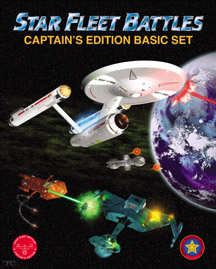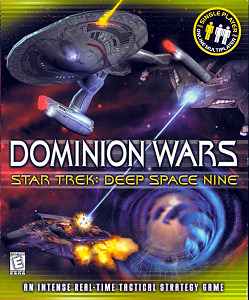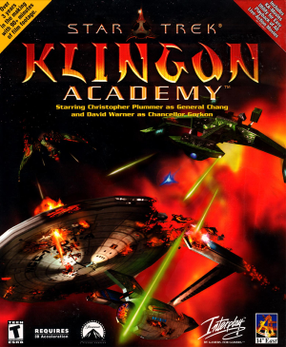Related Research Articles
The Star Trek fictional universe contains a variety of weapons, ranging from missiles to melee. The Star Trek franchise consists primarily of several multi-season television shows and a dozen movies, as well as various video games and inspired merchandise. Many aspects of the fictional universe impact modern popular culture, especially the lingo and the idea of a spacecraft launching space torpedoes and firing lasers, and have had a wide influence in the late 20th to early 21st century. Star Trek is popular enough that its science fiction concepts have even been studied by real scientists, and NASA described its science in relation to the real world as "entertaining combination of real science, imaginary science gathered from lots of earlier stories, and stuff the writers make up week-by-week to give each new episode novelty." For example, NASA noted that the Star Trek "phasers" were a fictional extrapolation of real-life lasers, and compared them to real-life microwave based weapons that have a stunning effect.

Star Fleet Battles (SFB) is a tactical board wargame set in an offshoot of the Star Trek setting called the Star Fleet Universe. Originally created in 1979 by Stephen V. Cole, it has had four major editions. The current edition is published by Amarillo Design Bureau as Star Fleet Battles, Captain's Edition.

GEnie was an online service created by a General Electric business, GEIS, that ran from 1985 through the end of 1999. In 1994, GEnie claimed around 350,000 users. Peak simultaneous usage was around 10,000 users. It was one of the pioneering services in the field, though eventually replaced by the World Wide Web and graphics-based services, most notably AOL.

Netrek is an Internet game for up to 16 players, written almost entirely in cross-platform open-source software. It combines features of multi-directional shooters and team-based real-time strategy games. Players attempt to disable or destroy their opponents' ships in real-time combat, while taking over enemy planets by bombing them and dropping off armies they pick up on friendly planets. The goal of the game is to capture all the opposing team's planets.
In the Star Trek franchise, the Klingon Empire makes use of several classes of starships. As the Klingons are portrayed as a warrior culture, driven by the pursuit of honor and glory, the Empire is shown to use warships almost exclusively and even their support ships, such as troop transports and colony ships, are armed for battle. This contrasts with the exploration and research vessels used by Starfleet, the protagonists of the franchise. The first Klingon ship design used in The Original Series, the D7-class battlecruiser, was designed by Matt Jefferies to evoke a shape akin to that of a manta ray, providing a threatening and instantly recognizable form for viewers. The configuration of Jefferies's design featured a bulbous forward hull connected by a long boom to a wing-like main hull with the engine nacelles mounted on each wingtip. Though a variety of Klingon ships have appeared in Star Trek, their design generally conforms to this style. Most Klingon vessels were physically built as scale models, although later computer-generated imagery was used to create the models. In recent years, many of the original studio models have been sold at auctions.

Star Trek is a text-based strategy video game based on the Star Trek television series (1966–69) and originally released in 1971. In the game, the player commands the USS Enterprise on a mission to hunt down and destroy an invading fleet of Klingon warships. The player travels through the 64 quadrants of the galaxy to attack enemy ships with phasers and photon torpedoes in turn-based battles and refuel at starbases. The goal is to eliminate all enemies within a random time limit.

Air Warrior was a multiplayer online combat flight simulation game launched by Kesmai in 1987. It was hosted on GEnie and used that service as a server for client software running on a variety of personal computers. It underwent continual improvement through its decade-long lifetime with Kesmai, appearing on new platforms and host services. Electronic Arts purchased Air Warrior in 1999, and became provider of the game, but it was discontinued in 2001. Sequels Air Warrior II and Air Warrior III were both released in 1997 and published by Interactive Magic.

Star Trek: Deep Space Nine: Dominion Wars is a 2001 space combat/real-time tactics video game for Microsoft Windows developed by Gizmo Industries and published by Simon & Schuster. The game is based on the Star Trek TV show Star Trek: Deep Space Nine.

Kelton Flinn is an American computer game designer who is a major pioneer in online games. He is a co-founder of the seminal online game company Kesmai, which they began in 1982. His best known title is the first graphical multi-player online game offered by a major service, Air Warrior (1987).

Star Raiders II is a video game released in 1986 for the Atari 8-bit family as a sequel to 1979's Star Raiders, which was the killer app for the Atari computers. The game was originally developed as part of a tie-in with the movie The Last Starfighter, which featured an arcade game of the same name as part of its plotline. Versions for the Atari 5200 and the Atari 8-bit computers were developed in 1984, although those were never released. Later the tie-in was dropped, and the game converted into a sequel to Star Raiders by changing a number of gameplay elements. The gameplay remained different from the original Star Raiders.
Star Trek: Legacy is a 2006 real-time tactics space combat video game for Microsoft Windows and Xbox 360 developed by Mad Doc Software and published by Bethesda Softworks in association with CBS Paramount Television and CBS Consumer Products. Originally slated for release in the fall of 2006 to coincide with the 40th anniversary of Star Trek, the Windows version was not released in North America until December 5, 2006, and the Xbox 360 version until December 15. In Europe, both the PC version and the Xbox 360 version were released on December 22, 2006.
"Rules of Engagement" was the 90th episode of the science fiction television series Star Trek: Deep Space Nine, the 18th episode of the fourth season. It was directed by LeVar Burton, and features guest star Ron Canada as a visiting Klingon prosecutor. The episode features special effect sequences with the USS Defiant and the Klingon Bird of Prey spaceships.

Star Trek: Klingon Academy is a space flight simulator video game developed by 14 Degrees East, an internal development house of publisher Interplay Entertainment. The game follows a young Klingon warrior named Torlek as he attends the Elite Command Academy, a war college created by General Chang to prepare warriors for a future conflict with the United Federation of Planets. Christopher Plummer and David Warner reprised their respective roles as Chang and Gorkon for the production of Klingon Academy.
Island of Kesmai was an early commercial online game in the multi-user dungeon (MUD) genre, innovative in its use of roguelike pseudo-graphics. It is considered a major forerunner of modern massively multiplayer online role-playing games (MMORPGs).
Empire is the name of a computer game written for the PLATO system in 1973. It is significant for being quite probably the first networked multiplayer arena shooter-style game. It may also be the first networked multiplayer action game.
Online games are video games played over a computer network. The evolution of these games parallels the evolution of computers and computer networking, with new technologies improving the essential functionality needed for playing video games on a remote server. Many video games have an online component, allowing players to play against or cooperatively with players across a network around the world.
MegaWars III was a massively multiplayer empire building game written by Kesmai and run continuously on CompuServe between 1984 and 1999. It was one of CompuServe's most popular games throughout its lifetime with thousands of players joining the month-long game cycles. It was only shut down after CIS was purchased by AOL and moved to the web-based "CompuServe 2000" interface that would not cleanly support it. A modified version, Stellar Emperor ran for much of the same time period on GEnie, also ending in 1999 when that service was shut down by General Electric. A new version of Stellar Emperor, sporting a new client-server GUI, was run for a short period on Kesmai's GameStorm.

Star Trek: The Rebel Universe is an action-adventure computer game published by Firebird Software in Europe and Simon & Schuster Interactive in America. It was originally released for the Atari ST in 1987, and was followed the next year with versions for the Commodore 64 and DOS.

Star Trek: 25th Anniversary is a 1992 Game Boy video game developed by Visual Concepts and published by Ultra, based upon the Star Trek universe. The game chronicles a mission of James T. Kirk and his crew of the USS Enterprise. Despite having the same name, the Game Boy version is not a port of the NES game or computer versions, and is in fact a completely different game. It was succeeded by Star Trek: The Next Generation for Game Boy, developed and published by Absolute Entertainment the following year.
John R. Taylor III is an American computer game designer, serial entrepreneur and massively multiplayer online game pioneer. He is a co-founder of the game company Kesmai, which they founded in 1981. In 2011, Taylor was awarded the Online Game Legend Award by the Computer Game Developers Association.
References
- 1 2 3 4 5 Harris S. Newman, "The DECWAR page", 24 March 2004
- 1 2 3 Game Development Essentials: An Introduction; Jeannie Novak; Cengage Learning; 2011; page 44
- 1 2 3 4 "DECWAR Game Instructions", DECWAR Version 2.3, 20 November 1981
- ↑ GsBrown, "DECWARS" Archived 2016-03-03 at the Wayback Machine , April 1982
- ↑ Source code, "UT Video Game Archive", 27 May 2011
- ↑ "Briscoe Center for American History",27 May 2011
- ↑ "Github repository, 17 June 2012
- ↑ Hysick, Bob; Potter, Jeff; Newman, Harris; Cousins, Merlyn (2011). "Decwar, Version 2.3 [Tops 10 port]". Cousins (Merlyn) Decwar Collection.
- ↑ "Decwar". GitHub . 29 May 2020.